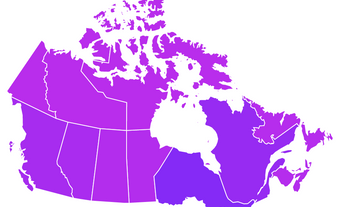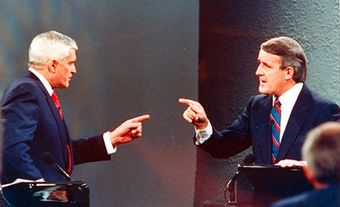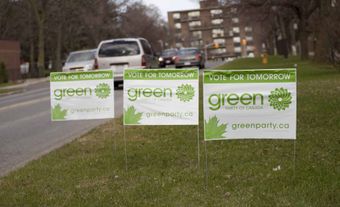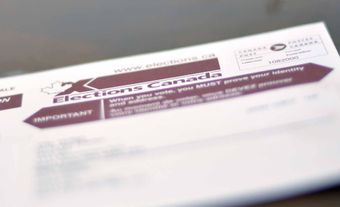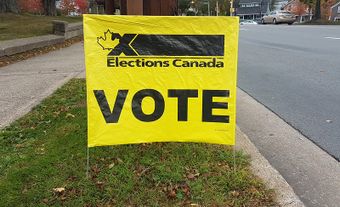Political parties are organizations that seek to control government. They participate in public affairs by nominating candidates for elections. ( See also Political Campaigning in Canada.) Since there are typically multiple groups that wish to do this, political parties are best thought of as part of a party system. This system dictates the way political parties conduct themselves in competition with one another. As of 2015, there were 23 registered political parties in Canada. The five major federal parties are the Liberal Party, the Conservative Party of Canada, the New Democratic Party (NDP), the Bloc Québécois and the Green Party of Canada.

Historical Background
For the first half-century after Confederation, Canada had a two-party system: Liberals and Conservatives. It was modelled after that of Great Britain. The Progressive Party’s rise to Official Opposition after the election of 1921 shattered Canada’s two-party system. Until the late 1950s, the Liberals and Conservatives were joined by groups such as the Canadian Co-operative Commonwealth Federation (CCF), the Progressive Party, the United Farmers of Alberta, Social Credit, the Bloc populaire canadien and the Labour Progressive Party.
In the early 1960s, Canada’s party system settled around the Liberals and Conservatives and the much smaller New Democratic Party (formerly the CCF). In 1993, Canada’s party system fragmented once again, with the rise of the Reform Party of Canada (which later morphed into the Canadian Alliance) and the Bloc Québécois. Those parties disappeared or diminished in importance. The Canadian party system has evolved to the point where three main parties compete for power. Various smaller parties organize in a more limited way.
Structure and Organization
Canada’s electoral system is based upon single-member constituencies. A political party tries to win a majority of seats in a general election to form a government. Political parties recruit members. They organize and fund their activities to nominate candidates to contest seats through political campaigns.
Canadian political parties function both nationally and locally. (See also Local Government; Provincial Government.) Federal and provincial campaigns — and that of Yukon — are party contests in which candidates represent political parties. Municipal campaigns — and those of Northwest Territories and Nunavut — are contested by individuals, not by parties.
Generally, the national party organization is dominated by the party’s elected members and leader. The national party organization sets policy and election strategy. At the same time, political parties also organize at the constituency level through local associations. These associations are typically the focus of membership activity. One of their primary functions is to choose the candidate the party will run in that constituency. They also deliver and adapt the party’s message to the local context.
Federal Political Parties
National political parties have existed since before Confederation. However, they were not formally recognized on ballots until 1970. Starting in 1974, political parties could register with Elections Canada. Registration entitles them to several privileges. The most important of these are the right to have the party’s name listed on the ballot underneath the names of its nominated candidates and the right to issue official tax receipts for financial contributions to the party. (See Political Party Financing in Canada.)
To be eligible for registration, parties need to meet certain legal requirements and have at least 250 members. To be registered, parties need to nominate a candidate in a general election or by-election. At the time of the 2015 federal election, there were 23 registered political parties in Canada. Only some of those, however, could reasonably expect to win seats in an election. The five major federal parties are the Liberal Party, the Conservative Party of Canada, the New Democratic Party (NDP), the Bloc Québécois and the Green Party of Canada.
Provincial Political Parties
Most provinces in Canada have party systems that reflect the parties in national politics. The dominant parties have tended to be Liberals, Conservatives and the Co-operative Commonwealth Federation (CCF)/ New Democratic Party (NDP). Provincial politics have featured more idiosyncratic parties, including the United Farmers of Alberta; the United Farmers of Ontario; Liberal-Progressive; Social Credit; Union Nationale; the Parti Québécois and the Saskatchewan Party.
There are often provincial parties with similar names or aims as national political parties; but Canadian parties are not generally well-integrated. The Conservative Party of Canada has no formal relationship with any provincial parties. The Liberal Party of Canada has more formal ties with the provincial Liberal parties; with the exception of the Parti libéral du Québec, which is independent, and the British Columbia Liberal Party, which is a centre-right party. It has not been affiliated with the federal Liberals since 1987. Provincial NDP parties are fully autonomous; except in Quebec, where formal ties exist between the Nouveau parti démocratique – Québec (NPD) and the federal party. According to the NDP charter, the NPD must “conduct itself in general consistency with the social democratic principles of the New Democratic Party of Canada.”
Despite the general lack of formal ties, however, there is often significant overlap between supporters of provincial and national parties of the same name.
Party Membership
Most Canadian political parties require their members to be Canadian citizens or permanent residents and not to be members of any other national parties. Members must also pay a nominal annual membership fee. Canadian parties typically provide limited opportunities for members to get involved outside of elections. During elections, however, party membership lists provide a source of volunteer labour. Members can participate in choosing party officers, delegates to conventions and local candidates. Relatively few Canadians join and participate in political parties. Parties typically do not publicize their membership numbers.
Representation
Political parties are important structures for representing the diversity of Canadian society. In the past, this largely centred around representing Canada’s linguistic duality; both in formal structures and in informal practices. For example, the Liberals traditionally alternate between francophone and anglophone leaders.
As Canadian society has become more diverse, there have been greater demands for inclusivity in parties. Many parties have responded with efforts to recruit more candidates from underrepresented groups, such as women and visible minorities. In 2015, 28 per cent of the nominated candidates were women. Among the five major parties (Bloc, Conservative, Green, Liberal, NDP), 33 per cent were women. Jagmeet Singh became the first racialized leader of a major national political party when he was elected leader of the NDP in 2017. In 2020, Green Party leader Annamie Paul became the first Black Canadian and the first Jewish woman to serve as leader of a major federal political party in Canada.
Party Financing
Political party activities, particularly media-intensive election campaigns, require great financial resources. Political parties aggressively fundraise, seeking contributions from members and supporters to fund their activities. Canadian national parties are limited by law to fundraising only from individuals and their financial activities are heavily regulated. (See also Political Party Financing in Canada.)
Candidates
Each general election involves simultaneous elections in all of Canada’s 338 ridings. In each constituency, there may be candidates from registered political parties; as well as representatives of other parties without registered status, whose names appear on the ballot as independents. (See also Canadian Electoral System.) In 2015, there were 1,792 candidates — the third-highest total ever for a Canadian general election. All but two constituencies had at least four candidates running; 48 electoral districts had seven or more.
At the local level, the most important task of the constituency association is to choose its candidate. The procedures for doing so are normally loosely established by the national political party. But there is considerable autonomy accorded to local parties, and their practices vary. Usually, the candidate is selected by a secret vote of all members in the constituency. It is also common for candidates to be acclaimed; particularly in areas where the party is weak, and few people are interested in becoming candidates.
There is a tradition of the local association choosing the candidate. But the party leader must approve any candidate running under the party’s name. This gives the national party a degree of control over the nomination process as the leader can refuse to approve a candidate chosen by the local association. This is sometimes used to ensure that a favoured contestant becomes the party candidate; or to help the party improve the diversity of its candidate pool. Such interventions are controversial, and party leaders use them sparingly.
Once the party’s candidate is chosen, the local party tries to secure his or her election. The party will choose a campaign manager, rent a campaign office and begin the process of publicizing the party and the candidate with signs and advertisements. Closer to the election, it will organize door-to-door canvasses and the distribution of literature. On election day, the local party focuses its efforts on encouraging its identified supporters to get out and vote.
Leadership
Party leaders are the central figures in political parties. They are in effect the party’s candidate for prime minister (or premier, at the provincial level). As a result, the selection of party leader is one of the most important tasks undertaken by parties. Normally, the selection of party leaders takes place after the resignation or death of the incumbent. Parties will also periodically call for or force a leadership review. In the first 50 years after Confederation, a party’s Members of Parliament (MPs) chose one from their ranks to lead the party. This system was supplanted by the leadership convention; delegates from the local party associations and other components of the party gathered in a central location to choose a leader. Only a few thousand of the party’s members would participate in these conventions.
In the 1990s, Canadian political parties began to switch to a system where all party members vote for their choice of leader. All major parties now choose their leader in this way. The Conservatives and Liberals weigh the votes in each constituency equally. This ensures that constituencies with large numbers of members do not dominate the process. Administering leadership votes takes significant resources. Parties have used combinations of in-person, telephone, postal and Internet ballots. These systems treat all party members equally. But they can create situations where the chosen leader has weak support among a party’s MPs or the party establishment.
The parties also elect a president and other executive members. Their job is to manage the party’s administrative apparatus. Most parties also hold policy conventions. These usually take place every two years. There is often debate between the MPs and participants in policy conventions as to how far elected members are bound by the resolutions established at such conventions. In a general election, it is the task of the national party to manage the overall national campaign. It plans the leader’s tour, raises and spends money on advertising and campaign literature, and distributes money and other resources. At other times, the parties operate offices with a small but paid staff. Their responsibility is to conduct party business and to coordinate the various constituency, provincial and national organizations.
Parliament
Political parties are central to the operation of parliamentary democracy in Canada. Almost all of the MPs elected to the House of Commons are elected as parts of political parties. Similarly, appointments to the Senate may also reflect party lines. However, support for partisan appointments has changed. The Liberal Party removed its senators from caucus in 2014. The NDP does not allow senators to sit under its banner. Party lines define political conflict in Parliament. MPs are expected to vote with their party in almost all cases. Weekly caucus meetings provide an opportunity for a party’s elected MPs and senators to meet, voice concerns and maintain cohesion.

Major Political Parties in Canada
Conservatives
At the time of Confederation, Canada’s politics were modelled on Britain’s system of parliamentary democracy. This meant that two broad-based political parties would compete for power. In the Conservative Party, Sir John A. Macdonald and Sir George-Étienne Cartier brought together a broad ruling coalition. (See Great Coalition of 1864.) It comprised a diverse collection of ideological, regional, religious and economic interests. At the political level, they allied the Tories of Canada West with the French-speaking Parti bleu of Canada East; along with business interests from the Maritimes. With the exception of the 1874 election, when Macdonald’s government was driven from office by the Pacific Scandal, the Conservative Party dominated Canadian politics until 1896.
In 1885, Macdonald allowed Métis leader Louis Riel to be hanged despite fierce Catholic opposition. This seriously weakened the alliances between the Ontario and Quebec wings of the Conservative Party. The Conservative party further alienated French Catholic voters with its implementation of conscription during the First World War. ( See also Election of 1917; Military Service Act; Union Government.)
The Conservatives’ lack of support in Quebec made it difficult for the party to compete nationally after the First World War. From 1921 until 1957, the Liberals dominated national politics. The Conservatives only won one election, in 1930; It was partly aided by voter dissatisfaction in the wake of the Great Depression. In 1942, after Progressive Party member John Bracken won the Conservative leadership, the party’s name was changed to the Progressive Conservative Party (PC). Several members of the Progressive Party moved to the PC. Others abandoned the Progressives for the CCF and the Liberals.

In 1957, John Diefenbaker led the party to a minority government and then to a landslide victory in 1958. (See Elections of 1957 and 1958.) Diefenbaker won significant support in Quebec. However, he was unable to manage this coalition. The Liberals came back to power in 1963. Western Canadian provinces had previously supported minor parties such as the Progressives and Social Credit. These provinces remained in the PC camp even after the Conservatives’ defeat.
As in the period before Diefenbaker, the PC had difficulty competing with the Liberals’ ability to bridge Quebec and the other provinces. This changed in 1984 when PC leader Brian Mulroney led the party to a landslide victory. Mulroney did this by bringing Quebec into the PC fold. He wedded that province’s support with the Conservatives’ traditional western support base. However, Mulroney’s pursuit of constitutional reform exposed the disagreements between western Canada and Quebec over Canadian identity. (See Meech Lake Accord; Charlottetown Accord.) The western wing of the party largely left to form the Reform Party in 1987. The Quebec wing of the party left to form the Bloc Québécois in 1990. After the 1993 election, the Progressive Conservative party lay in ruins; it was reduced to only two seats in the House of Commons.
The Progressive Conservative party languished throughout most of the 1990s. It slowly increased its support to a handful of seats across the country. Meanwhile, the Reform Party (reformed as the Canadian Alliance in 2000) had difficulty expanding beyond its western support base. In 2003, the Canadian Alliance and Progressive Conservatives merged to form the Conservative Party of Canada. It chose Canadian Alliance leader Stephen Harper as leader in 2004. Harper led the Conservative Party of Canada to two minority governments in 2006 and 2008 and to a majority government in 2011. Harper’s careful, incremental pursuit of neo-conservative public policy led to a slow increase in support. However, the party continued to struggle with gaining support in Quebec.
(See also Conservative Party.)

The Conservative Party of Canada's official logo, adopted in September 2020.
Liberals
At its inception, the Liberal Party rested on a much narrower base than the Conservatives. The Clear Grits of Canada West joined the anticlerical Parti rouge of what is now Quebec; along with the reform element in the Maritimes led by Joseph Howe. Little united these factions except for a common dislike of John A. Macdonald.
The rise of Wilfrid Laurier to the leadership in 1887 transformed the party. Laurier was elegantly bilingual and a politician of genius. He neutralized the hostility of the Roman Catholic Church in Quebec toward the concept of political liberalism. His victory in the election of 1896 laid the groundwork for decades of Liberal domination in Quebec and for the party’s predominance in the next century. Laurier lost office, however, when he again proposed free trade with the United States in 1911. (See Reciprocity.) Robert Borden and the Conservatives succeeded Laurier and led the country through the First World War. Borden solidified the deep anti-Conservative sentiment in Quebec by imposing conscription in 1917. Many Québécois were in strong opposition, as they considered the conflict an English, not a Canadian, war. ( See Election of 1917.)
When Laurier died in 1919, his successor was William Lyon Mackenzie King. King’s political philosophy prepared Canada, slowly but surely, for the welfare state. His cautious statesmanship led the country through the Great Depression and the Second World War. From the time King became leader, it would be fair to describe Canada as a single-party dominant state. For example, since 1921, the Conservatives have won five majority governments; the Liberals have won 12.

Louis St-Laurent (1948–58), a stolid lawyer, succeeded King. St-Laurent was followed by Lester B. Pearson (1958–68). He laid the plan for Canada Pension Plan and Canada’s bilingualism and biculturalism policies. When Pierre Trudeau first took office in 1968, his government seemed radical. But it practiced a cautious management style. When he returned to office in 1980, he introduced the Charter of Rights and Freedoms. (See also Elections of 1979 and 1980.)
In 1984, the Liberals lost much of their Quebec support base to the Conservatives. The Liberals were swept from office. Aided partly by a divided opposition, the party came back to power in 1993 under Jean Chrétien. The Liberals won three consecutive majority governments. Their parliamentary domination rested on a steady and relatively high share of the popular vote. After the Sponsorship Scandal came to light, the Liberals were reduced to a minority government in 2004 under Paul Martin. In 2006, the Liberals lost power. The party then went through a succession of leaders and faced a decline in voter support. In 2011, the party was reduced to 34 seats and third place in the House of Commons. The Liberals won a majority government under Justin Trudeau in 2015 but were reduced to a minority government in 2019.
(See also Liberal Party.)

New Democratic Party (NDP)
Other parties were formed during the 20th century to challenge the dominance of the Liberals and the Conservatives. The Co-operative Commonwealth Federation (CCF) grew from the Progressive Party, a farm-based party led by Thomas Crerar from Manitoba and Henry Wise Wood in Alberta. Crerar and Wood were radical populists. They fought against the influence of the large financial interests such as banks and railways. As a national party, the Progressives survived for about 15 years. Some Progressive and United Farmers of Alberta Members of Parliament helped found the CCF in 1932.
The CCF’s Regina Manifesto of 1933 defined the party as social democratic. Tommy Douglas led the party to power in Saskatchewan in 1944; it became the first democratically elected social democratic government in North America. (see Tommy Douglas: “Greatest Canadian”.) It remained the leading party of the left until it faced near electoral annihilation in 1958. (See Elections of 1957 and 1958.) In 1961, it decided to ally with the recently formed Canadian Labour Congress (CLC) to form the New Democratic Party (NDP).

The NDP provided Canada with a “two-and-a-half-party” system until the 1990s; a system in which the two large parties — the Liberals and Conservatives — were joined by a smaller party. A combination of weak leadership, scandal at the provincial level, competition from other protest parties and trade union dissatisfaction seriously weakened the party. It reached a point where some, including its own members, questioned its survival.
The NDP was revived under the leadership of Jack Layton. He became party leader in 2003. Layton’s likeable image, combined with his efforts to professionalize the party’s electoral machinery, helped restore the NDP’s place in the party system. In May 2011, Layton led the NDP to its best-ever election result; it finished second with 103 seats and became the Official Opposition. Much of the NDP’s breakthrough came from Quebec.
After Layton died of cancer in August 2011, the task of turning the NDP from the government in waiting to the party in power fell to Tom Mulcair. In the 2015 election, however, Mulcair ran a cautious campaign. He was outflanked on the left by Liberal leader Justin Trudeau, who promised deficit spending and electoral reform. The NDP was reduced to third place with 44 seats. In the 2019 election, it fell to fourth place and 24 seats under new leader Jagmeet Singh.

Bloc Québécois
The Bloc Québécois was founded as a parliamentary movement. It was formed by Members of Parliament from Quebec ridings who left the Conservative and Liberal parties after the failure of the Meech Lake Accord. The parliamentary bloc was led by Lucien Bouchard, who had been a Conservative cabinet minister. He resigned his seat and soon after formed the Bloc Québécois political party.
The Bloc runs candidates solely in the province of Quebec. Its principal policy is to promote Quebec’s interests and Quebec sovereignty in the House of Commons. In the 1993 election, the Bloc received the second-most seats (54) and became the Official Opposition. But the party slowly declined in support. It was almost obliterated in the 2011 election when it lost all but four seats. However, in the 2019 election, the Bloc ate into the NDP’s support in Quebec; it claimed 32 seats to the NDP’s 24.
Green Party
The Green Party of Canada was founded in 1983 to promote environmental concerns. The party ran small numbers of candidates with little voter support until 2004. Changes to Canada’s party finance laws meant that a party that earned two per cent of the vote nationally would receive public funding. Under leader Jim Harris, the Greens nominated a full slate of candidates for the 2004 election and qualified for the funding.
The combination of increased party resources and growing environmental consciousness among voters led to the growth of the party. It received seven per cent of the vote in 2008. Elizabeth May, who became leader of the party in 2006, won the Greens’ first ever seat in the House of Commons in 2011. She was succeeded as leader by Annamie Paul, the first Black Canadian and the first Jewish woman to lead a major federal party.
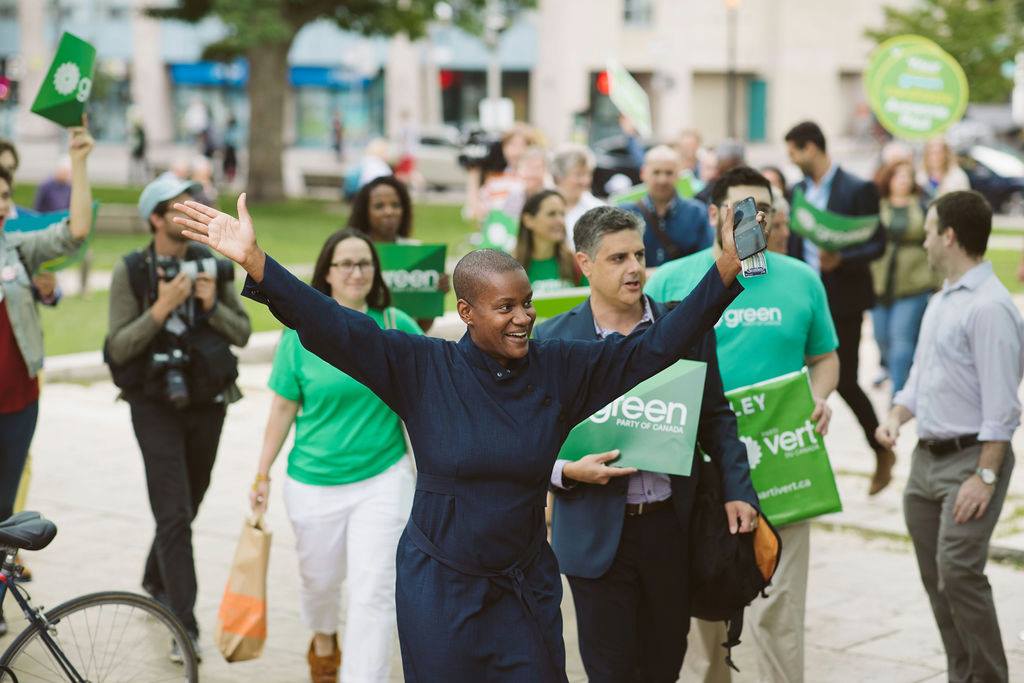
Fringe Parties
Canada has seen a variety of very small parties that meet the criteria for registration but earn small shares of the vote and do not win seats in the House of Commons. Some of these parties, such as the Communist, Christian Heritage or Canadian Action parties, have lasted for a long period of time. Others might only contest one or two elections before fading away. These parties have little success electorally. But they allow their supporters to participate in the debate over the direction of the country.
Significance
Political parties are important to the health of Canadian democracy. They help to organize political competition and structure the operation of our political system. As organizations, however, there are signs that Canada’s political parties are weakening. The membership base of political parties is aging and declining. Fewer Canadians identify themselves as party supporters. Voter turnout in Canada has declined in the last two decades, raising questions about the ability of parties to connect with voters. Canadian parties are as important as ever in the operation of our political institutions. But their connection with the electorate is increasingly tenuous.
See also Political Participation; Political Party Financing in Canada; Political Campaigning in Canada; Canadian Electoral System; Chief Electoral Officer; Electoral Behaviour.

 Share on Facebook
Share on Facebook Share on X
Share on X Share by Email
Share by Email Share on Google Classroom
Share on Google Classroom


